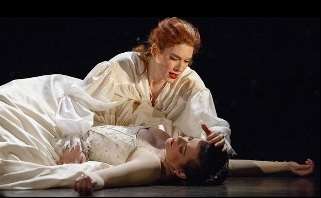|
Back
Gluck via Berlioz Toronto
The Elgin Theatre
04/09/2015 - & April 11, 12, 14, 17, 18*, 2015
Christoph Willibald Gluck (arr. Berlioz): Orphée et Eurydice
Mireille Lebel (Orphée), Pegy Kriha Dye (Euridice), Meghan Lindsay (Amour)
The Tafelmusik Baroque Orchestra and Chamber Choir, David Fallis (conductor)
Marshall Pynkoski (director), Jeannette Lajeunesse-Zingg (choreographer), Gerard Gauci (set designer), Margaret Lamb (costume designer), Michelle Ramsay (lighting designer)

M. Lebel & P. Kriha Dye (© Bruce Zinger)
Over the years Opera Atelier has performed the two Orpheus operas by Gluck: his 1762 version (Orfeo ed Euridice) in Italian, with either a counter tenor or mezzo replacing the original castrato in the lead role, and the 1774 (Orphée et Eurydice) in French, with a tenor in the lead role and extra music for him and for dancers.
Hector Berlioz revered Gluck and regretted the disappearance of the work from the French repertory. One problem was that the tonality of operatic music had crept higher, thus putting the tenor lead role out of reach for contemporary singers. In 1859 he devised a third version with the lead role sung by a mezzo and had the good fortune of having the now-legendary Pauline Viardot to help establish his revision.
Berlioz was respectful of Gluck and the only substantial difference is that the fact of the mezzo in the lead role. He made minor changes in instrumentation but refrained from juicing up the orchestration to make the work sound like, say his own classical-flavoured Les Troyens. The 35-member Tafelmusik Baroque Orchestra under David Fallis gave their typically vibrant account of the score despite a few intonation lapses (unusual for this group). The 19-member chorus gave forth some startlingly savage sounds as the Furies.
The role of Orphée truly bears the weight of the work and Mireille Lebel is a worthy performer, although there were times I wished for more alto-esque gutsiness in her tone. The acoustical deficiencies of the Elgin Theatre are a factor here as well. She bravely tackled the exposed coloratura at the end of “Amour, viens rendre à mon âme” and handled it well.
OA stalwart Peggy Kriha Dye gave a glowing account of Eurydice, especially in her opening number, the ecstatic “Cet asile aimable et tranquille”. Life in the Elysian Fields seems so blissful one wonders why she would want to leave. Meghan Lindsay gives a lively account of Amour, staged here as a mischievous sprite just as the character appears in so much mythology. Still, she gives full weight to the serious rules Orphée must follow in order to bring Euridice back to life.
The attractive designs of Gerard Gauci (sets) and Margaret Lamb (costumes), last seen in 2007 when the company performed the 1774 version, made a welcome reappearance.
As in all OA productions, any opportunity for dancing is seized upon. There is more dancing in this production than in Paris in 1859 (for example, the final celebratory dance) because the theatre in which it was played then did not have the requisite ballet troupe. Choreographer Jeannette Lajeunesse-Zingg has brought the dancing style forward in time to an extent, recognizing, for example, the development toward the modern ballet slipper that took place in the early 1800s.
Next season is OA’s thirtieth and they will be celebrating with a revival of their well-travelled production of Lully’s Armide and then bringing to Toronto Marshall Pynkoski and Jeannette Lajeunesse-Zingg’s production of Mozart’s Lucio Silla, first produced in Salzburg in 2013 and then earlier this year performed at La Scala, Milan.
Michael Johnson
|